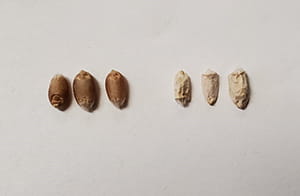By Mackenzie Hladun, MSc, AAg, Crops Extension Specialist, Moose Jaw
March 2024
Seed-borne diseases can be pesky; they can lead to an accumulation of disease in your field and spread through subsequent crop years. Following a dry year like 2023, disease levels are often thought to be low. However, disease can still happen in dry years, and being aware of the amount of disease in your area is important for determining the next steps. Interim data submitted by seed labs around the province show the average per cent infection of seed-borne diseases in both cereals and pulse crops. This information can be a powerful tool in knowing how to protect your next crop. This information is even stronger when combined with your own seed test. Testing your seed for disease, vigour and germination is important preparation for seeding.

and viability.
Pictured here are healthy wheat seeds (left)
compared to Fusarium damaged kernels (right).
There are many different pathogens that can infect the seed and impact the crop, causing seedling blight and damping off effect. Each disease level has a threshold, and the threshold can vary by pathogen and crop type. Detailed information on mitigating seed-borne diseases and preventing further infection for pulse crops and cereal crops is available.
If you’re in an area with a high infection of a seed-borne diseases, put your best crop forward by applying mitigation strategies to your seed. Seed cleaning, treating seed with a fungicide seed treatment and getting your seed tested are three important strategies for dealing with contaminated seed. Cleaning your seed can help remove some of the diseased seed from the lot. Treating with a fungicide seed treatment can prevent further infection of the pathogen into the plant and protect from seedling blight and rots. As always, follow the label; you can find more information in the 2024 Guide to Crop Protection. As mentioned above, testing your seed can help you make informed decisions.
Ensure your seed is the best it can be for this year’s crop. Contact your local crops extension specialists or call the Agriculture Knowledge Centre at 1-866-457-2377 to learn more.
